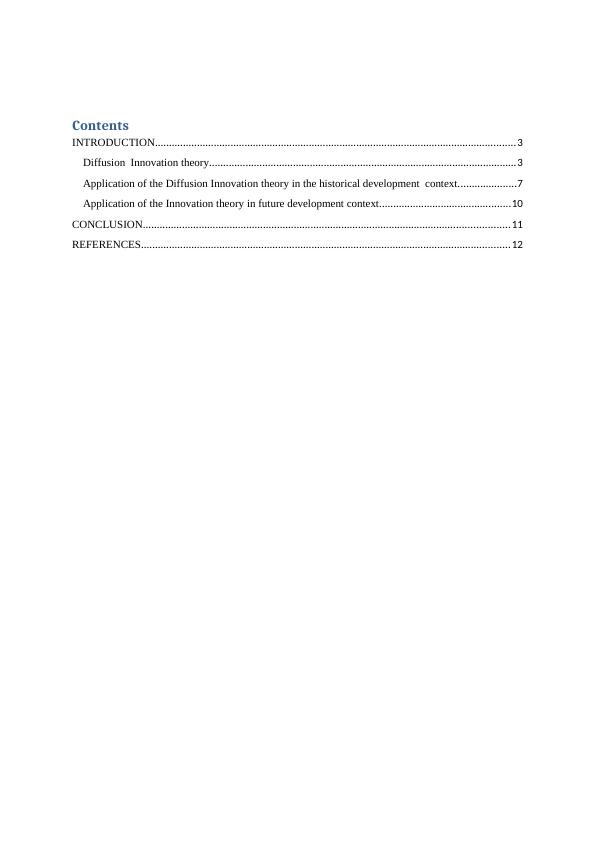Managing Innovation: Application of Diffusion Innovation Theory in Historical Development Context
14 Pages3664 Words47 Views
Added on 2023-01-12
About This Document
This article explores the application of diffusion innovation theory in the historical development context. It discusses the benefits and limitations of the theory and provides a case study of WeWork company.
Managing Innovation: Application of Diffusion Innovation Theory in Historical Development Context
Added on 2023-01-12
ShareRelated Documents
Managing Innovation

Contents
INTRODUCTION.................................................................................................................................3
Diffusion Innovation theory..............................................................................................................3
Application of the Diffusion Innovation theory in the historical development context.....................7
Application of the Innovation theory in future development context...............................................10
CONCLUSION...................................................................................................................................11
REFERENCES....................................................................................................................................12
INTRODUCTION.................................................................................................................................3
Diffusion Innovation theory..............................................................................................................3
Application of the Diffusion Innovation theory in the historical development context.....................7
Application of the Innovation theory in future development context...............................................10
CONCLUSION...................................................................................................................................11
REFERENCES....................................................................................................................................12

INTRODUCTION
Innovation is one the crucial part of business and it is very helpful for company to
conduct its products and services in better and effective manner (Tidd and Bessant, 2018).
Innovation can be describe as completely new or different thing that is implemented by
organisation. It consist of new idea, method, products, design and so on. It is important for
organisation to manage its innovative products and ideas in order to conduct its business
activities and task in required manner. There are various ways through which company can
manage innovation in required and effective manner. Diffusion innovation theory is one of
the effective theory that can be used by company in order to successful management its
innovative process and activities in organisation. This theory of innovation can be describe as
the process in through which organisation can easy spread in desired market. Diffusion of
innovation theory which will support organisation to make new product adopted by targeted
audience. With the help of this theory organisation will be able to determined the main reason
why some products or services are more successful as compare to other products. This theory
includes different steps in its process which is helpful in determining the complete decision
making process in managing innovation.
Diffusion Innovation theory
Definitions, Principals and Processes of the theory
Diffusion of innovation theory is considered as one of the oldest theory of social
science and this was developed in 1962 by E.M Rogers. The motive of developing this theory
is to identify and analyse how an idea as well as product is spread through a specific social
system or population. This is very effective theory in order to determine the impact of
diffusion on organisation. It will also help in determine the people as a social system, adopter
of new idea, behaviour or products. Diffusion theory is very effective in examine different
ways though which a company can spread its idea of innovation among various group of
people. It is essential for organisation to determine the different types of adopter in market.
Diffusion theory of innovation includes different steps helpful in gaining information or
taking better decision as well as implementing its is successful manner. In this adoption can
be describe as the person who is some in different manner which in never done before
(Biemans, 2018). For example a person is considered to be adopter when they use
completely new product as well as acquire new behaviour. In order to manage innovation, it
Innovation is one the crucial part of business and it is very helpful for company to
conduct its products and services in better and effective manner (Tidd and Bessant, 2018).
Innovation can be describe as completely new or different thing that is implemented by
organisation. It consist of new idea, method, products, design and so on. It is important for
organisation to manage its innovative products and ideas in order to conduct its business
activities and task in required manner. There are various ways through which company can
manage innovation in required and effective manner. Diffusion innovation theory is one of
the effective theory that can be used by company in order to successful management its
innovative process and activities in organisation. This theory of innovation can be describe as
the process in through which organisation can easy spread in desired market. Diffusion of
innovation theory which will support organisation to make new product adopted by targeted
audience. With the help of this theory organisation will be able to determined the main reason
why some products or services are more successful as compare to other products. This theory
includes different steps in its process which is helpful in determining the complete decision
making process in managing innovation.
Diffusion Innovation theory
Definitions, Principals and Processes of the theory
Diffusion of innovation theory is considered as one of the oldest theory of social
science and this was developed in 1962 by E.M Rogers. The motive of developing this theory
is to identify and analyse how an idea as well as product is spread through a specific social
system or population. This is very effective theory in order to determine the impact of
diffusion on organisation. It will also help in determine the people as a social system, adopter
of new idea, behaviour or products. Diffusion theory is very effective in examine different
ways though which a company can spread its idea of innovation among various group of
people. It is essential for organisation to determine the different types of adopter in market.
Diffusion theory of innovation includes different steps helpful in gaining information or
taking better decision as well as implementing its is successful manner. In this adoption can
be describe as the person who is some in different manner which in never done before
(Biemans, 2018). For example a person is considered to be adopter when they use
completely new product as well as acquire new behaviour. In order to manage innovation, it

is crucial for organisation to understand and determine the characteristics of individual or
targeted customers. Categorise of adopter classified into five different parts which is explain
below in detail.
Innovators – This type of person can be describe as those individual who are first to
try something new. Innovators are very interest in experiencing new ideas of
innovation. They are ready or willing to take risk of innovation in order to implement
new and creative idea. Person with innovator categories are considered as first person
to try innovation. It include very little appealing for this population to adopt
innovation.
Early adopters – This category of adopter can considered to be larders who easily
adopt new and innovative technology or products. early adopters can be represented a
the opinion leaders as well as they enjoy the role of leadership (Tidd. and Bessant,
2014). They are very well aware about new idea and innovation along with it benefits.
Early adaptors understand the needs or requirement of changes as well as importance
of adopting innovation. They are responsible for developing and creating strategies so
that population can easily adopt changes.
Early majority – Population of this category are not considered as leaders but they do
adopt new ideas and innovation faster as compare to other average population size. In
order to adopt innovation, early majority needs to see evidences which will help in
analysing the innovation work in better manner. As per the evidences early majority
will take their decision. It is crucial that strategies are very appealing as well as
effective in order to adopt innovation.
Late majority – This type of population category are considered to be sceptical of
changes and they will only adopt changes when it is adopted by majority of
population. It is important for them that innovation and new idea in well tried and
tested by other population size (Wang and Tsai, 2014). So that they can adopt changes
accordingly. Strategies for late majority needs to be very appealing as well as
informative. It is crucial for them to understand and evaluate the information that will
includes how many other has successful adopted the changes along with its impact.
Laggards – These are the person who are bounded with their tradition and they are
very conservative. Laggards are considered as the most hardest group of people to
adopt changes. They are not ready to adopt new ideas and innovation and it is very
targeted customers. Categorise of adopter classified into five different parts which is explain
below in detail.
Innovators – This type of person can be describe as those individual who are first to
try something new. Innovators are very interest in experiencing new ideas of
innovation. They are ready or willing to take risk of innovation in order to implement
new and creative idea. Person with innovator categories are considered as first person
to try innovation. It include very little appealing for this population to adopt
innovation.
Early adopters – This category of adopter can considered to be larders who easily
adopt new and innovative technology or products. early adopters can be represented a
the opinion leaders as well as they enjoy the role of leadership (Tidd. and Bessant,
2014). They are very well aware about new idea and innovation along with it benefits.
Early adaptors understand the needs or requirement of changes as well as importance
of adopting innovation. They are responsible for developing and creating strategies so
that population can easily adopt changes.
Early majority – Population of this category are not considered as leaders but they do
adopt new ideas and innovation faster as compare to other average population size. In
order to adopt innovation, early majority needs to see evidences which will help in
analysing the innovation work in better manner. As per the evidences early majority
will take their decision. It is crucial that strategies are very appealing as well as
effective in order to adopt innovation.
Late majority – This type of population category are considered to be sceptical of
changes and they will only adopt changes when it is adopted by majority of
population. It is important for them that innovation and new idea in well tried and
tested by other population size (Wang and Tsai, 2014). So that they can adopt changes
accordingly. Strategies for late majority needs to be very appealing as well as
informative. It is crucial for them to understand and evaluate the information that will
includes how many other has successful adopted the changes along with its impact.
Laggards – These are the person who are bounded with their tradition and they are
very conservative. Laggards are considered as the most hardest group of people to
adopt changes. They are not ready to adopt new ideas and innovation and it is very

End of preview
Want to access all the pages? Upload your documents or become a member.
Related Documents
Managing Innovationlg...
|14
|4030
|42
Diffusion Of Innovation Assignmentlg...
|14
|4256
|84
Diffusion of Innovationlg...
|6
|1423
|330
Managing Innovationlg...
|12
|3846
|59
Managing Innovationlg...
|20
|3984
|51
Managing Innovationlg...
|11
|3592
|33
